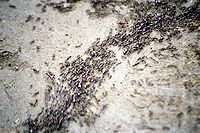
Photo from wikipedia
A random search process in a networked environment is governed by the time it takes to visit every node, termed the cover time. Often, a networked process does not proceed… Click to show full abstract
A random search process in a networked environment is governed by the time it takes to visit every node, termed the cover time. Often, a networked process does not proceed in isolation but competes with many instances of itself within the same environment. A key unanswered question is how to optimize this process: How many concurrent searchers can a topology support before the benefits of parallelism are outweighed by competition for space? Here, we introduce the searcher-averaged parallel cover time (APCT) to quantify these economies of scale. We show that the APCT of the networked symmetric exclusion process is optimized at a searcher density that is well predicted by the spectral gap. Furthermore, we find that nonequilibrium processes, realized through the addition of bias, can support significantly increased density optima. Our results suggest alternative hybrid strategies of serial and parallel search for efficient information gathering in social interaction and biological transport networks.
Journal Title: Physical Review E
Year Published: 2018
Link to full text (if available)
Share on Social Media: Sign Up to like & get
recommendations!